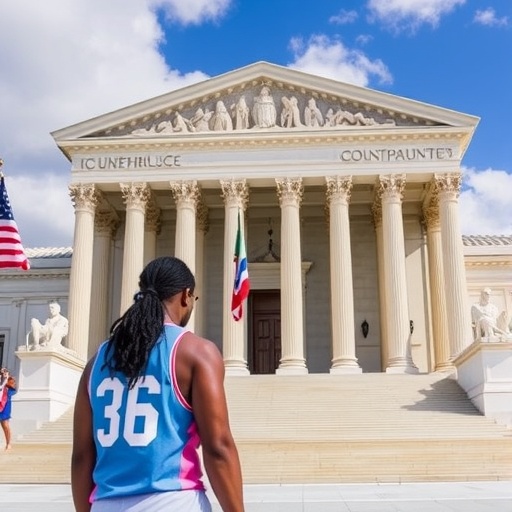Supreme Court Set to Rule on Transgender Athletes and Voting Rights Act: Landmark Battles for Equal Protection and Minority Representation
In a move that could reshape the landscape of civil rights in America, the U.S. Supreme Court has agreed to hear two explosive cases this term—one challenging the participation of transgender athletes in school sports and another scrutinizing key sections of the Voting Rights Act. These decisions, expected by mid-2025, carry the weight of defining equal protection under the law and safeguarding minority representation in elections, potentially affecting millions from high school locker rooms to national ballots.
- Transgender Athletes Face Uphill Battle in Competitive Sports Arena
- Voting Rights Act Under Fire: Renewed Assault on Section 2 Protections
- Equal Protection Threads Linking Sports Bans and Ballot Boxes
- Grassroots Mobilization Intensifies Amid National Stakes
- Timeline Ahead: Oral Arguments, Decisions, and Ripple Effects
The announcements come amid heightened national debates on identity and democracy, with advocates on both sides mobilizing. For transgender youth, the sports case represents a fight for inclusion; for voting rights groups, it’s a bulwark against erosion of hard-won electoral gains. As the Supreme Court docket fills with these high-stakes matters, the justices’ rulings could echo through state legislatures, school boards, and polling stations for decades.
Transgender Athletes Face Uphill Battle in Competitive Sports Arena
The first case, B.P.J. v. West Virginia State Board of Education, stems from a 2021 West Virginia law banning transgender girls from competing in female sports categories. At its heart is Becky Pepper-Jackson, a 13-year-old transgender girl who sued after being sidelined from her middle school track team. Now in her late teens, Pepper-Jackson’s story has become a rallying cry for transgender rights organizations, highlighting the personal toll of such bans.
Supporters of the ban argue it preserves fairness in women’s sports, citing physiological advantages from male puberty. Data from the American College of Sports Medicine shows that even after hormone therapy, transgender women may retain up to 10-20% strength advantages in certain events like swimming or weightlifting. West Virginia Attorney General Patrick Morrisey has emphasized this in filings, stating, “Protecting opportunities for cisgender female athletes isn’t discrimination—it’s equity.”
Opponents, including the ACLU representing Pepper-Jackson, counter that such laws violate Title IX, the federal law prohibiting sex-based discrimination in education. They point to studies from the Journal of Medical Ethics indicating that hormone suppression levels the playing field sufficiently, with no widespread dominance by transgender athletes. In fact, a 2023 NCAA report found only 48 openly transgender athletes among over 500,000 participants, underscoring their rarity.
The case’s path to the Supreme Court was paved by lower court splits. The 4th U.S. Circuit Court of Appeals struck down the ban in 2023, ruling it discriminatory under the Equal Protection Clause of the 14th Amendment. But the full appeals court reheard it en banc, and the Supreme Court stepped in after West Virginia appealed. Oral arguments are slated for January 2025, where justices will grapple with balancing inclusion against competitive integrity.
Beyond the legal fray, the emotional stakes are profound. Transgender youth already face bullying rates four times higher than peers, per a 2022 Trevor Project survey. Exclusion from sports could exacerbate mental health crises, with suicide attempt rates among transgender teens hovering at 41%. “This isn’t just about running a race—it’s about affirming a child’s identity,” said Lambda Legal’s Jennifer Pizer in a recent press conference.
Voting Rights Act Under Fire: Renewed Assault on Section 2 Protections
Parallel to the sports saga, the Supreme Court will revisit the Voting Rights Act (VRA) in Merrill v. Milligan, a challenge to Alabama’s congressional redistricting map accused of diluting Black voters’ influence. Enacted in 1965 amid the Civil Rights Movement, the VRA aimed to dismantle Jim Crow-era barriers, but recent rulings have chipped away at its teeth.
Section 2 of the VRA prohibits voting practices that abridge minority representation, requiring districts drawn to ensure fair electoral opportunities. In Alabama, Black voters comprise 27% of the population but were packed into one majority-Black district out of seven, despite data suggesting two were feasible. The case exploded when a federal trial court ordered a redraw in 2023, only for the Supreme Court to pause it pending appeal.
Historical context looms large. The VRA’s original formula under Section 5—requiring federal preclearance for changes in covered jurisdictions—was gutted by the Court’s 2013 Shelby County v. Holder decision, leading to a surge in restrictive laws. Since then, 20 states have enacted voter ID requirements, purge voter rolls, or limit mail-in voting, disproportionately affecting communities of color. A Brennan Center analysis estimates these measures suppressed up to 2 million votes in 2020, with Black turnout dropping 5% in affected areas.
Alabama’s defense hinges on the Equal Protection Clause, arguing race-neutral redistricting. Solicitor General Elizabeth Prelogar, representing the Biden administration, has filed briefs warning that upholding the map would invite gerrymandering nationwide. “The VRA isn’t a relic—it’s a living shield for democracy,” she asserted during lower court proceedings.
Civil rights leaders invoke the legacy of Bloody Sunday in Selma, where John Lewis marched for voting access. The NAACP’s Derrick Johnson recently told reporters, “If the Court weakens Section 2, we’re backsliding to an era where minority representation is an illusion, not a reality.” Polling from Pew Research shows 68% of Americans support strong voting protections, yet partisan divides run deep, with Republicans favoring state control.
Key Statistics Highlighting Voting Disparities
- Black voters waited an average of 29 minutes at polls in 2020, compared to 12 minutes for white voters (MIT Election Data Lab).
- Post-Shelby, 1,688 polling places closed in former VRA jurisdictions, 80% in majority-minority counties (ACLU).
- In Alabama, Black residents are 2.5 times more likely to live in poverty, correlating with lower registration rates (U.S. Census Bureau).
These figures paint a stark picture of systemic inequities, fueling fears that a conservative-leaning Court could further erode safeguards.
Equal Protection Threads Linking Sports Bans and Ballot Boxes
What unites these disparate cases is the Equal Protection Clause, a cornerstone of the 14th Amendment promising impartial treatment under the law. In the transgender athletes dispute, plaintiffs argue that blanket bans stereotype and marginalize a vulnerable group, akin to past exclusions based on race or sex. Legal scholars draw parallels to Brown v. Board of Education (1954), where segregation was deemed inherently unequal.
For the Voting Rights Act, equal protection manifests in preventing vote dilution, ensuring minority representation isn’t diluted by clever map-drawing. Justice Elena Kagan, in a 2022 dissent on a related Arizona case, warned that ignoring racial impacts invites “second-class citizenship.” Both battles test the Court’s commitment to substantive equality versus formal neutrality.
Amicus briefs flood in from unexpected quarters. For the sports case, the Biden administration and 22 states support transgender inclusion, while 20 states back the ban. In voting rights, tech giants like Google advocate for diverse representation, citing innovation benefits from inclusive electorates. A 2023 Harvard study links stronger minority representation to policies reducing income inequality by 15% in represented districts.
Surprising angles emerge: Some conservative scholars, like those at the Heritage Foundation, argue VRA challenges protect against “racial gerrymandering,” flipping the narrative on equal protection. Meanwhile, transgender advocates highlight overlaps with voting, noting that marginalized groups often face compounded barriers—transgender voters report harassment at rates 50% higher than average (Williams Institute).
The justices’ composition adds intrigue. With a 6-3 conservative majority, past rulings like Bostock v. Clayton County (2020)—extending Title VII protections to LGBTQ+ workers—suggest nuance on transgender issues. Yet Students for Fair Admissions v. Harvard (2023) curtailed affirmative action, signaling wariness toward race-conscious remedies that could spill into VRA interpretations.
Grassroots Mobilization Intensifies Amid National Stakes
As the Supreme Court prepares, activism surges. In sports, groups like Athlete Ally have organized “Play Fair” rallies in 15 states, drawing thousands. Personal stories dominate: One Ohio transgender swimmer shared in a viral video how exclusion led to depression, amassing 2 million views and sparking petitions with 500,000 signatures.
Voting rights coalitions, including the Leadership Conference on Civil and Human Rights, launched a “Defend Democracy” tour, visiting swing states like Georgia and Arizona. They’ve collected testimonials from elders who marched in the 1960s, emphasizing intergenerational stakes. “My vote was bought with blood; we can’t let it be stolen by ink on a map,” said 82-year-old activist Fannie Lou Hamer in a recorded message.
Statistics underscore urgency. Transgender youth participation in sports has risen 300% since 2017 (GLAAD), yet bans in 24 states threaten reversal. On voting, a 2024 Democracy Docket report predicts that without robust VRA enforcement, minority representation in Congress could drop 10% by 2030, skewing policy on healthcare and education.
Public opinion polls reflect division: A Gallup survey shows 69% oppose transgender athletes in women’s sports, but 55% support VRA expansions. This split tests the Court’s role as a unifier or divider.
Timeline Ahead: Oral Arguments, Decisions, and Ripple Effects
The Supreme Court term kicks off October 7, 2024, with transgender athletes arguments likely in early 2025, followed by VRA hearings in spring. Decisions typically drop by June, but emergency stays could prolong battles into election season.
Potential outcomes? An upset for transgender rights might invalidate state bans, spurring federal guidelines under Title IX. A VRA win could mandate redistricting in states like Louisiana and South Carolina, boosting Black congressional seats by 5-7.
Broader ripples: Enhanced equal protection could embolden challenges to other discriminations, from healthcare access to employment. Conversely, setbacks might fuel state-level workarounds, deepening divides. Experts like NYU’s Richard Hasen predict “a pivotal moment for American democracy,” urging Congress to shore up laws preemptively.
As briefs are filed and previews air, the nation watches. These cases aren’t abstract—they’re about who gets to play, who gets to vote, and who shapes tomorrow’s America. With midterms looming in 2026, the stakes feel immediate, promising narratives of triumph or tragedy that will dominate headlines for years.










